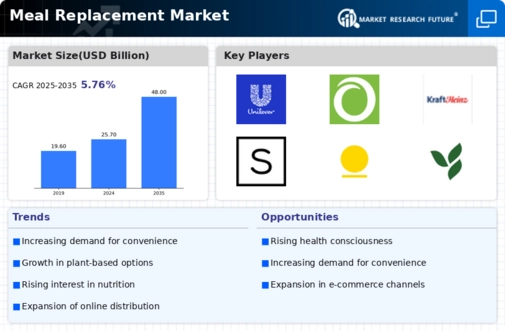The Meal Replacement Market is currently characterized by a dynamic competitive landscape, driven by evolving consumer preferences towards health and convenience. Key players such as Herbalife (US), Nestle (CH), and Huel (GB) are strategically positioning themselves through innovation and product diversification. Herbalife (US) has focused on expanding its product line to include plant-based options, appealing to the growing vegan demographic. Meanwhile, Nestle (CH) has been investing in research and development to enhance the nutritional profile of its meal replacement products, thereby catering to health-conscious consumers. Huel (GB) emphasizes sustainability in its operations, which resonates with environmentally aware consumers, thus shaping a competitive environment that prioritizes health, sustainability, and innovation.
The Meal Replacement Market exhibits a moderately fragmented structure, with numerous players vying for market share. Key business tactics include localizing manufacturing to reduce costs and optimize supply chains, which is particularly relevant in the current economic climate. Companies are increasingly focusing on regional expansion to tap into emerging markets, thereby enhancing their competitive positioning. The collective influence of these key players fosters a competitive atmosphere where innovation and operational efficiency are paramount.
In August 2025, Herbalife (US) launched a new line of meal replacement shakes specifically designed for athletes, which underscores its commitment to catering to niche markets. This strategic move not only diversifies its product offerings but also positions the company as a leader in the sports nutrition segment of the meal replacement market. By targeting athletes, Herbalife (US) aims to capture a growing demographic that prioritizes performance and recovery, thereby enhancing its market share.
In September 2025, Nestle (CH) announced a partnership with a leading technology firm to integrate AI into its product development processes. This collaboration is expected to streamline operations and enhance product personalization, allowing Nestle (CH) to better meet consumer demands. The integration of AI signifies a shift towards data-driven decision-making, which could potentially revolutionize how meal replacement products are developed and marketed.
In July 2025, Huel (GB) expanded its distribution channels by entering into a strategic alliance with a major online retailer. This move is indicative of the growing trend towards e-commerce in the meal replacement sector, allowing Huel (GB) to reach a broader audience. By leveraging the online retailer's established customer base, Huel (GB) is likely to enhance its visibility and accessibility, which is crucial in a market increasingly dominated by digital sales.
As of October 2025, the Meal Replacement Market is witnessing trends such as digitalization, sustainability, and the integration of advanced technologies like AI. Strategic alliances are becoming increasingly vital, as companies seek to enhance their competitive edge through collaboration. The competitive differentiation is likely to evolve from traditional price-based competition to a focus on innovation, technology, and supply chain reliability. This shift suggests that companies that prioritize these aspects will be better positioned to thrive in the future.





















